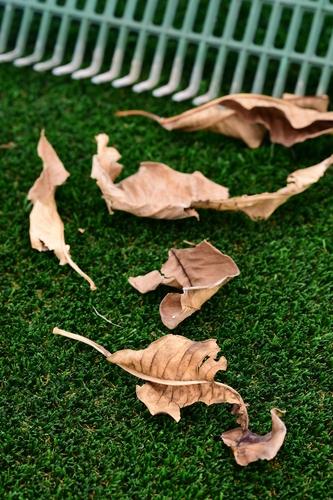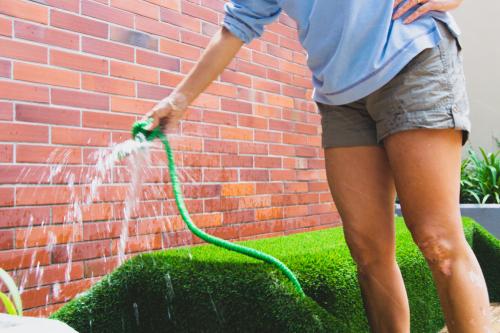Artificial grass is a low maintenance alternative to a real lawn, although many people believe that this means no maintenance. While fake lawns do not require watering or mowing like traditional lawns, there is still some upkeep required to make sure yours stays in good condition. Just like with any home (or, in this case, garden) furnishing, you need to care for your artificial lawn on a regular basis so that it has longevity and proves to be a good investment.
A little goes a long way and carrying out just a small amount of light maintenance work once a month can save you a huge job at the end of the year. Small jobs like brushing, weeding and cleaning will ensure that your artificial lawn stays looking great for years to come.
So, let's take a look at how to care for your artificial lawn in a way that keeps it green and lush for longer.

Brush it Off
When artificial lawns are newly laid, they have a sand infill that slowly structures the turf. In order to ensure the turf is in optimum condition when it settles, it is important to let it settle. After this, the lawn will only require some maintenance. We would recommend you do this by brushing with a stiff, natural bristle broom.
When you do brush your lawn, be sure you brush it in all different directions, so you keep the turf pile bouncy and upright - think fluffy not comb over!
Of course, you will need the best brush for the job and we suggest a stiff, natural-bristle brush which will be gentle but effective on your artificial grass. Although brushing might seem like light work, it will make a noticeable difference to the appearance and condition of your lawn.
Areas of higher foot traffic may require brushing more regularly to prevent blades from looking flattened or trampled.
Keep Your Lawn Free of Debris
Artificial grass lawns have a membrane backing that, though ideal for letting water run through, minimises the risk of unwanted plants and weeds that grow through normal grass patches. That being said, the tenacity of certain weeds and mosses mean that the odd one may come through anyway, so it is best to be prepared and know how to tackle weeds and moss should they appear.
Unlike when you weed natural grass, you can't go digging through your artificial grass with a trowel or fork. Instead, you have two choices. The first is to focus purely on the cosmetic, taking off the tops of weeds when they show through the grass, without really addressing the root of the problem.
Alternatively, you could use a moss or weed killer BUT if you do, make sure it is a water-based solution to avoid damaging the artificial turf. Once the moss and weeds are dead, you can simply remove them by hand or brush them off.
Any organic debris like leaves and dead plants should be removed from your artificial lawn as quickly as possible. This is because a build-up of organic matter can damage the lawn's drainage and encourage weed growth. You can collect the debris by hand, with a brush or even use a leaf blower - just make sure you keep on top of it.

Stubborn Stain Removal
The resistant material of an artificial grass lawn means that you ought to be able to remove stains and marks quickly, using hot soapy water (washing up liquid is fine for the job). Tougher oil marks and such can be removed using a cloth and some mineral spirits. While heavily diluted detergents can be used, it’s best to stick to specific artificial grass cleaning products to prevent damage.
If you have to clean up animal mess then make sure it is removed as soon as possible, followed by a wash of the area using hot soapy water where necessary.
Seasonal Maintenance
While regular brushing should take place monthly, there is some maintenance that only takes place during certain seasons. During the summer, when you are more likely to be out in the garden, high traffic areas should be carefully maintained.
While your artificial lawn is protected against damage caused by frost, areas of heavy snowfall should be allowed to melt naturally. Removing compressed snow and ice can be damaging or cause thinning of artificial grass blades.
Bonus Tips
- Avoid sharp or pointy objects coming into contact with your synthetic lawn - this includes broken glass, stiletto shoes and rugby or football studded boots
- Never use hard chemicals or strong detergents like bleach on your lawn. Hot soapy water is enough to clean stubborn stains
- Make sure you keep your chewing gum and adhesives well away from your synthetic lawn
- Keep motor vehicles off the artificial grass, except for wheelbarrows, bicycles and wheelchairs which shouldn't cause any issues
- To reduce the amount of leaf litter and debris that falls on your artificial grass, cut back hedges and over-hanging trees
- Don't keep or use sources of heat on the artificial grass (or too near to it). Smoking, bonfires and fireworks are all no-goes and barbecues should always be placed on safe, solid surfaces like gravel or slabs
- Avoid putting mirrors or reflective surfaces anywhere that could potentially reflect sunlight onto your lawn as this can cause burning and leave areas unrepairable
- Watch out for the damage that children and pets can do to artificial lawns. Dogs will normally be put off digging in the presence of artificial grass but on the odd occasion they do dig, they run the risk of ripping the underlay. Similarly, if children purposely pick off blades of synthetic grass, your lawn will look bald because the grass won't grow back. An artificial lawn is ideal for kids and pets, but make sure you pay attention to how they treat it
These are just a few simple steps to maintaining an artificial lawn so it stays in top condition for longer. If you have any other queries about how to care for your lawn or if you would like to discuss the benefits of artificial grass in more detail, then get in touch with the Artificial Lawn Company today. We're always happy to help with any questions or queries you may have!
